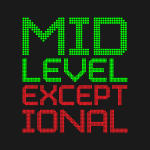Explaining the Maximum Contract
We hear the phrase “maximum contract” tossed around all the time when it comes to free agency. The NBA puts a cap on how much a single player can earn in salary, essentially to prevent an owner from throwing a stupid amount of money at a LeBron James or a Kevin Durant. While it seems like a simple concept, there tend to be a lot of nuances when it comes to arriving at exactly how much a player will make after signing a maximum contract.
Why is one player’s maximum contract worth more than another’s? How do you arrive at the exact number? Kyrie Irving just signed a max deal with the Cavs, why won’t he earn as much as Kobe?
To start, there are two basic factors: years of experience, and the salary cap figure for that given year.
As far as years are concerned, there are three groups; those with 0-6 years of experience, 7-9 years, and 10+ years. The idea here is that, essentially, players who have serviced the league longest deserve to earn more money. This notion is consistent with the minimum salary scale, which also rewards players for their experience.
The second basic factor is the salary cap. As the cap increases or decreases, the maximum contract either grows or shrinks. With the success the league has been having, I wouldn’t bet on the cap decreasing any time soon. You can see the chart combining years of experience along with the proper percentage of the cap below, via CBA guru Lary Coon.
| Years in NBA | Defined maximum salary | 2011-12 | 2012-13 | 2013-14 |
|---|---|---|---|---|
| 0 – 6 | 25% of cap | $12,922,194 | $13,668,750 | $13,701,250 |
| 7 – 9 | 30% of cap | $15,506,632 | $16,402,500 | $16,441,500 |
| 10+ | 35% of cap | $18,091,071 | $19,136,250 | $19,181,750 |
The first year of James Harden’s extension with the Houston Rockets kicked in this season. He entered the season with four years of experience, so he earned $13,701,250 this year.
In practice, the above chart becomes less useful for players with more than six years of experience. By this point, a max contract caliber player has probably already signed one during his first six years in the league, introducing more factors. So, to keep confusion at a minimum, we’ll leave it at that for now.
Combine the two factors, and there you have it! A max contract! Easy, right?
Of course, it isn’t quite that simple. After you arrive at the tentative max figure, you have to take into consideration that once a player is a free agent, he has the right to earn a salary that starts no lower than 105% of his last deal. Simply put, if you’re the kind of player who can accumulate multiple maximum contracts over the course of a career, that last one will be worth quite a bit of salary. As the cap rises and that 105% multiplies, you will be a rich man on that last maximum deal.
To earn this 105%, a player does not have to stay with the same team. He can look elsewhere around the league and still get his 105%.
This 105% factor is not sensitive to the league minimum of a maximum deal. So, if the 105% ends up being more than the number in the table above, the 105% is what you will be paid. This gives you an idea of how Kobe Bryant will make so much more than $19 million next year.
If Dirk Nowitzki elects not to take a pay cut, although he likely will, this would come into play. Via Sham Sports, Dirk earned $22,721,381 this past season. His current cap hold is for $23,857,450, which represents 105% of his 2013-2014 salary. If you look back at our chart above, you’ll notice that this is obviously more than $19 million. So, for a player like Dirk who has been at the top of his position for a long time, this factor can add up to some serious dough.
Ok, got it! Years of experience, percentage of the salary cap, and then figure out how much the 105% comes out to, right?
Nah. There’s yet another layer.
There is a wrinkle in the CBA that is in place to reward younger players for achieving certain criteria early in their career. The idea here is that if you dangle extra money in front of young players, they’ll work harder to earn it, which helps create a better product for the league. If a player reaches any of the below criteria after four years of service, they are eligible for the “5th Year 30% Max” contract:
- Be named to one of the All-NBA teams twice (can be First, Second, or Third team)
- Be voted as a starter in the All Star game twice
- Be named League MVP
You’ve probably heard the unofficial term for this before: it’s the Derrick Rose Rule. It’s awfully hard to meet the requirements, particularly at such a young age. Because Rose had, he was eligible for a max contract worth 30% of the salary cap, despite the fact that he didn’t have more than six years of experience. Thus, Rose’s reward was an extra 5% of the Chicago salary cap in his pocket.
So, yes: fan voting for All Star starters could affect whether or not your favorite player will earn 30% of your cap or 25%. It’s crazy to think that fan voting can have such an impact on a player’s salary, but it’s how the CBA is set up.
Finally, we must talk about how raises within maximum contracts work, and why a player does not make the same amount every year. The CBA rewards players for remaining with their team when signing a max deal with a 7.5% annual raise, as opposed to the 4.5% annual raise given to a player signing a new team. This 7.5% raise can still be had in a sign and trade; a player signs a max deal with his old team as a formality, and is then immediately traded to where he really wishes to go.
Additionally, a player with three or more years of service with his team is eligible for a five year maximum contract, as opposed to the standard four.
When we’re talking about millions of dollars, that annual 3% and extra year adds up. This summer, we could see this difference play out between Kyrie Irving, who is staying with his team, and Gordon Hayward, who may be leaving.
I ran a quick Excel analysis comparing a player leaving for a max deal and a player staying for a max deal. It doesn’t adjust for cap increaes, because we don’t know what those will be yet, but you can see the assumptions and outcomes below:
Now, of course a player who signs with a new team will be able to sign a new contract in that fifth year, so it’s not as if he’ll earn nothing. Still, with age and injuries, guaranteed money is huge. Just ask Amar’e.
Hopefully this helps clarify why so many maximum contracts are not the same. There are a variety of factors; years of experience, what year you were drafted, the league salary cap figure at the time, prior contracts, etc.
Essentially, the CBA lays a framework for the max, then takes into account previous earnings, and also rewards players for exceeding expectations while they’re young. The math gets messy, and the players become very wealthy.


